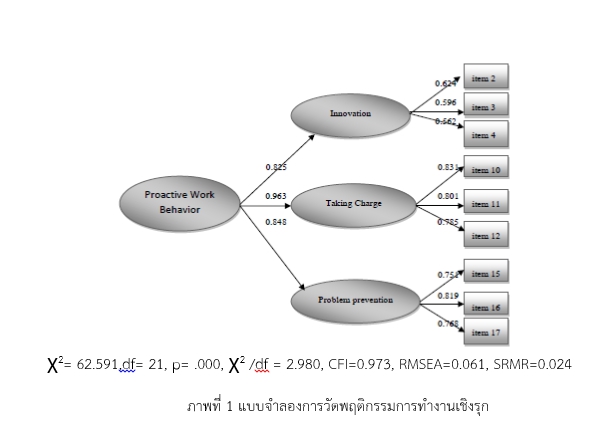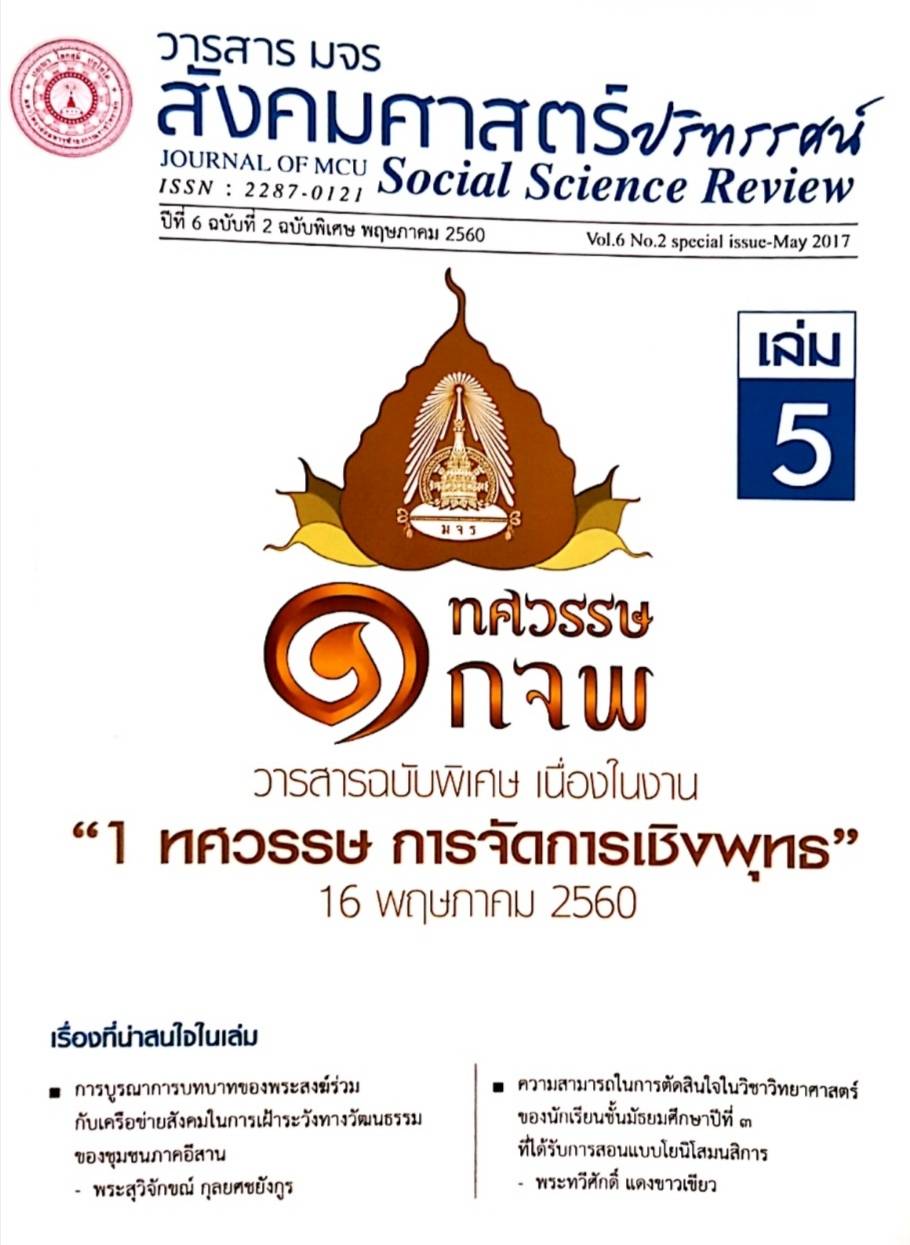การพัฒนาและตรวจสอบเครื่องมือวัดพฤติกรรมการทำงานเชิงรุก
บทคัดย่อ
การศึกษาครั้งนี้มีวัตถุประสงค์เพื่อสร้างและพัฒนาเครื่องมือวัดพฤติกรรมการทำงานเชิงรุกให้มีคุณภาพเที่ยงตรง และเชื่อถือได้ กลุ่มตัวอย่างคือข้าราชการที่ปฏิบัติงานด้านนโยบายและแผนของหน่วยงานในสังกัดกระทรวงทรัพยากรธรรมชาติและสิ่งแวดล้อม จำนวน 534 คน เก็บข้อมูลด้วยแบบวัดพฤติกรรมการทำงานเชิงรุกซึ่งได้รับการตรวจสอบความเที่ยงตรงเชิงเนื้อหาจากผู้ทรงคุณวุฒิ และมีค่าความเชื่อมั่นทั้งฉบับอยู่ที่ 0.90 ผลการศึกษาโดยการวิเคราะห์องค์ประกอบเชิงยืนยันพบว่า พฤติกรรมการทำงานเชิงรุกประกอบด้วย 3 องค์ประกอบ ได้แก่ การนำความคิดเชิงรุกไปปฏิบัติ การมีนวัตกรรม และการป้องกันปัญหา และเมื่อตรวจสอบสอบคุณภาพของแบบวัดพฤติกรรมการทำงานเชิงรุก พบว่ามีความเที่ยงตรงเชิงเสมือน(Convergent validity) และมีความเชื่อมั่นในการวัดตัวแปรแฝง (Construct reliability) ในระดับที่เชื่อถือได้ โดยมีค่าความเชื่อมั่นในการวัดตัวแปรแฝงอยู่ที่ 0.67, 0.85 และ 0.82 ตามลำดับ

เอกสารอ้างอิง
สำนักงานคณะกรรมการข้าราชการพลเรือน. (2553). คู่มือการกำหนดสมรรถนะในราชการพลเรือน : คู่มือสมรรถนะเฉพาะตามลักษณะงานที่ปฏิบัติ. กรุงเทพฯ: ประชุมช่าง จำกัด.
อาภรณ์ ภู่วิทยพันธ์. (2548). เทคนิคการทำงานเชิงรุก : สร้างพลังในการทำงานที่ดีและมีประสิทธิภาพ. กรุงเทพฯ: เอช อาร์ เซ็นเตอร์ จำกัด.
Ashford, S. J, & Cummings, L.L. (1985) .Proactive feedback seeking: the instrumental use of the information environment. Journal of Occupational Psychology. 58: 67-79.
Bateman, T. S., & Crant, J. M. (1993). The Proactive Component of Organizational Behavior: A Measure and Correlates. Journal of Organizational Behavior. 14 (2): 103-118.
____________.(1999). Proactive Behavior: Meaning Impact Recommendations. Business Horizons : 63-70.
Covey, S. R. (1989). The Seven Habits of Highly Effective People. New York: Designed by Irving Perkins Associates.
Crant, J. M. (2000). Proactive behavior in organizations. Journal of Management, 26(3): 435–462
Crowley, S.L, & Fan, X. (1997). Structural equation modeling: Basic concepts and applications in personality assessment. Journal of Personality Assessment, 68, 508-531.
Fornell, C., & Larcker,D.F. (1981). Evaluation Structural Equation Models with Unopservable Variables and Measurement Error. Journal of Marketing Research, 18(1), 39-50.
Frese, M.; Fay, D., Hilburger, T., Leng, K., & Tag, A. (1997). The concept of personal initiative: Operationalization, reliability and validity in two German samples. Journal of Occupational and Organizational Psychology. 70: 139–161.
Grant, A. M., & Ashford, S. J. (2008). The dynamics of proactivity at work: Lessons from feedback-seeking and organizational citizenship behavior research. In B. M. Staw & R. M. Sutton (Eds.), Research in organizational behavior. 28: 3-34. Amsterdam: Elsevier.
Grant, A. M., Parker, S., & Collins, C. (2009). Getting credit for proactive behavior: Supervisor reactions depend on what you value and how you feel. Personnel Psychology . 62: 31-55.
Hair, Joseph F., et al. (2006). Multivariate Data Analysis 6Th ed. Pearson Education,Inc.
Hair, J. F., Jr., Black, W. C., Babin, B. J.; & Anderson, R. E. (2010). Multivariate Data Analysis: A Global Perspective. 7th ed. New Jersey: Prentice Hall.
Kipnis, D., Schmidt, S.M., & Wikinson, I. (1980). Intraorganizational influence tactics: Exploration in getting one’ way. Journal of Applied Psychology.65: 440-452.
Morrison, E. W., & Phelps, C. C. (1999). Taking Charge at Work: Extra-role efforts to Initiate Workplace Change. Academy of Management Journal. 42: 403–419.
Nunnally, J. C. (1978). Psychometric theory. New York: McGraw Hill.
Parker, S. K., Williams, H. M., & Turner, N. (2006). Modeling the antecedents of proactive behavior at work. Journal of Applied Psychology, 91: 636-652.
Parker, S. K., & Collins, C. G. (2010). Taking stock: Integrating and differentiating multiple proactive behaviors. In Journal of Management. 36 (3): 633-662.
Ping, R. A. (2007). Is There any way to improve Average Variance Extracted (AVE) in a latent variable(LV) X? Retrieved from
http://home.att.net/ ~rpingjr/ LowAVE.doc
Seibert, S. E., Crant, J. M., & Kraimer, M. L. (1999). Proactive personality and career success. Journal of Applied Psychology. 84: 416–427.
Searle, T. P., & Barbuto, J. E. (2011). Servant leadership, hope, and organizational virtuousness: A framework exploring the positive micro and macro behaviors and its performance impact. Journal of Leadership and Organizational Studies. 18 (1) : 107-117.
Tabacnick, Barbara G., & Fidell, Linda, S. (1996). Using Multivariate Statistics. 3 rd ed. New York: Harper Collins.
Van Dyne, L., & LePine, J. A. (1998). Helping and Voice extra-role Behaviors: Evidence of Construct and Predictive Validity. Academy of Management Journal .
ดาวน์โหลด
เผยแพร่แล้ว
รูปแบบการอ้างอิง
ฉบับ
ประเภทบทความ
สัญญาอนุญาต
ลิขสิทธิ์ (c) 2020 วารสาร มจร สังคมศาสตร์ปริทรรศน์

อนุญาตภายใต้เงื่อนไข Creative Commons Attribution-NonCommercial-NoDerivatives 4.0 International License.
เพื่อให้เป็นไปตามกฎหมายลิขสิทธิ์ ผู้นิพนธ์ทุกท่านต้องลงลายมือชื่อในแบบฟอร์มใบมอบลิขสิทธิ์บทความให้แก่วารสารฯ พร้อมกับบทความต้นฉบับที่ได้แก้ไขครั้งสุดท้าย นอกจากนี้ ผู้นิพนธ์ทุกท่านต้องยืนยันว่าบทความต้นฉบับที่ส่งมาตีพิมพ์นั้น ได้ส่งมาตีพิมพ์เฉพาะในวารสาร มจร สังคมศาสตร์ปริทรรศน์ เพียงแห่งเดียวเท่านั้น หากมีการใช้ภาพหรือตารางหรือเนื้อหาอื่นๆ ของผู้นิพนธ์อื่นที่ปรากฏในสิ่งตีพิมพ์อื่นมาแล้ว ผู้นิพนธ์ต้องขออนุญาตเจ้าของลิขสิทธิ์ก่อน พร้อมทั้งแสดงหนังสือที่ได้รับการยินยอมต่อบรรณาธิการ ก่อนที่บทความจะได้รับการตีพิมพ์ หากไม่เป็นไปตามข้อกำหนดเบื้องต้น ทางวารสารจะถอดบทความของท่านออกโดยไม่มีข้อยกเว้นใดๆ ทั้งสิ้น





